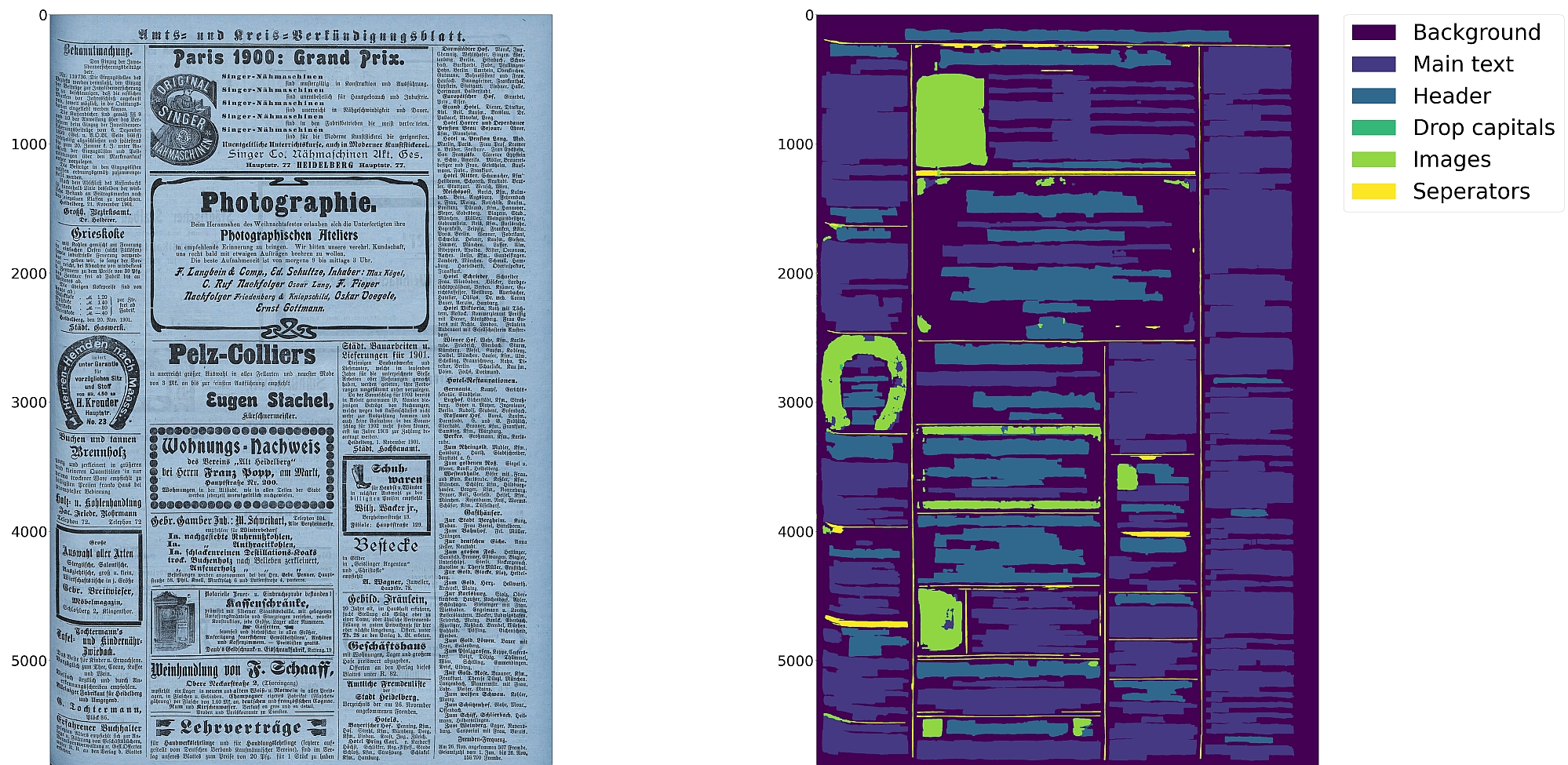Document Layout Analysis
Project description
Eynollah
Document Layout Analysis with Deep Learning and Heuristics
Features
- Support for up to 10 segmentation classes:
- background, page border, text region, text line, header, image, separator, marginalia, initial, table
- Support for various image optimization operations:
- cropping (border detection), binarization, deskewing, dewarping, scaling, enhancing, resizing
- Text line segmentation to bounding boxes or polygons (contours) including for curved lines and vertical text
- Detection of reading order (left-to-right or right-to-left)
- Output in PAGE-XML
- OCR-D interface
:warning: Development is currently focused on achieving the best possible quality of results for a wide variety of historical documents and therefore processing can be very slow. We aim to improve this, but contributions are welcome.
Installation
Python 3.8-3.11 with Tensorflow <2.13 on Linux are currently supported.
For (limited) GPU support the CUDA toolkit needs to be installed.
You can either install from PyPI
pip install eynollah
or clone the repository, enter it and install (editable) with
git clone git@github.com:qurator-spk/eynollah.git
cd eynollah; pip install -e .
Alternatively, you can run make install or make install-dev for editable installation.
Models
Pre-trained models can be downloaded from qurator-data.de or huggingface.
For documentation on methods and models, have a look at models.md.
Train
In case you want to train your own model with Eynollah, have a look at train.md.
Usage
The command-line interface can be called like this:
eynollah \
-i <single image file> | -di <directory containing image files> \
-o <output directory> \
-m <directory containing model files> \
[OPTIONS]
The following options can be used to further configure the processing:
| option | description |
|---|---|
-fl |
full layout analysis including all steps and segmentation classes |
-light |
lighter and faster but simpler method for main region detection and deskewing |
-tab |
apply table detection |
-ae |
apply enhancement (the resulting image is saved to the output directory) |
-as |
apply scaling |
-cl |
apply contour detection for curved text lines instead of bounding boxes |
-ib |
apply binarization (the resulting image is saved to the output directory) |
-ep |
enable plotting (MUST always be used with -sl, -sd, -sa, -si or -ae) |
-eoi |
extract only images to output directory (other processing will not be done) |
-ho |
ignore headers for reading order dectection |
-si <directory> |
save image regions detected to this directory |
-sd <directory> |
save deskewed image to this directory |
-sl <directory> |
save layout prediction as plot to this directory |
-sp <directory> |
save cropped page image to this directory |
-sa <directory> |
save all (plot, enhanced/binary image, layout) to this directory |
If no option is set, the tool performs layout detection of main regions (background, text, images, separators and marginals). The best output quality is produced when RGB images are used as input rather than greyscale or binarized images.
Use as OCR-D processor
Eynollah ships with a CLI interface to be used as OCR-D processor,
formally described in ocrd-tool.json.
In this case, the source image file group with (preferably) RGB images should be used as input like this:
ocrd-eynollah-segment -I OCR-D-IMG -O OCR-D-SEG -P models 2022-04-05
If the input file group is PAGE-XML (from a previous OCR-D workflow step), Eynollah behaves as follows:
-
existing regions are kept and ignored (i.e. in effect they might overlap segments from Eynollah results)
-
existing annotation (and respective
AlternativeImages) are partially ignored:- previous page frame detection (
croppedimages) - previous derotation (
deskewedimages) - previous thresholding (
binarizedimages)
- previous page frame detection (
-
if the page-level image nevertheless deviates from the original (
@imageFilename) (because some other preprocessing step was in effect likedenoised), then the output PAGE-XML will be based on that as new top-level (@imageFilename)ocrd-eynollah-segment -I OCR-D-XYZ -O OCR-D-SEG -P models 2022-04-05
Still, in general, it makes more sense to add other workflow steps after Eynollah.
Additional documentation
Please check the wiki.
How to cite
If you find this tool useful in your work, please consider citing our paper:
@inproceedings{hip23rezanezhad,
title = {Document Layout Analysis with Deep Learning and Heuristics},
author = {Rezanezhad, Vahid and Baierer, Konstantin and Gerber, Mike and Labusch, Kai and Neudecker, Clemens},
booktitle = {Proceedings of the 7th International Workshop on Historical Document Imaging and Processing {HIP} 2023,
San José, CA, USA, August 25-26, 2023},
publisher = {Association for Computing Machinery},
address = {New York, NY, USA},
year = {2023},
pages = {73--78},
url = {https://doi.org/10.1145/3604951.3605513}
}
Project details
Release history Release notifications | RSS feed
Download files
Download the file for your platform. If you're not sure which to choose, learn more about installing packages.
Source Distribution
Built Distribution
File details
Details for the file eynollah-0.4.0.tar.gz.
File metadata
- Download URL: eynollah-0.4.0.tar.gz
- Upload date:
- Size: 106.5 kB
- Tags: Source
- Uploaded using Trusted Publishing? No
- Uploaded via: twine/6.1.0 CPython/3.11.9
File hashes
| Algorithm | Hash digest | |
|---|---|---|
| SHA256 |
315e8bda8cc0c76243edafd9143a9c79972090a46e192a37f72413450f1256e5
|
|
| MD5 |
3a111b577fcefb21a019760e2040b222
|
|
| BLAKE2b-256 |
d579ace5cc6f3c799cf4e0eb61f21c8be11153c99e681c818acac18f5a8569bd
|
File details
Details for the file eynollah-0.4.0-py3-none-any.whl.
File metadata
- Download URL: eynollah-0.4.0-py3-none-any.whl
- Upload date:
- Size: 105.5 kB
- Tags: Python 3
- Uploaded using Trusted Publishing? No
- Uploaded via: twine/6.1.0 CPython/3.11.9
File hashes
| Algorithm | Hash digest | |
|---|---|---|
| SHA256 |
a358037890406d895f7bbd00153856398f2eea40c4557b0da3211de09d143a82
|
|
| MD5 |
164743e9e12a3f20c9826a2aad20aece
|
|
| BLAKE2b-256 |
57e0ebd51feb5e0a3bc0d8d0265331b9811bd4c3510701110882a781ad06e181
|
















